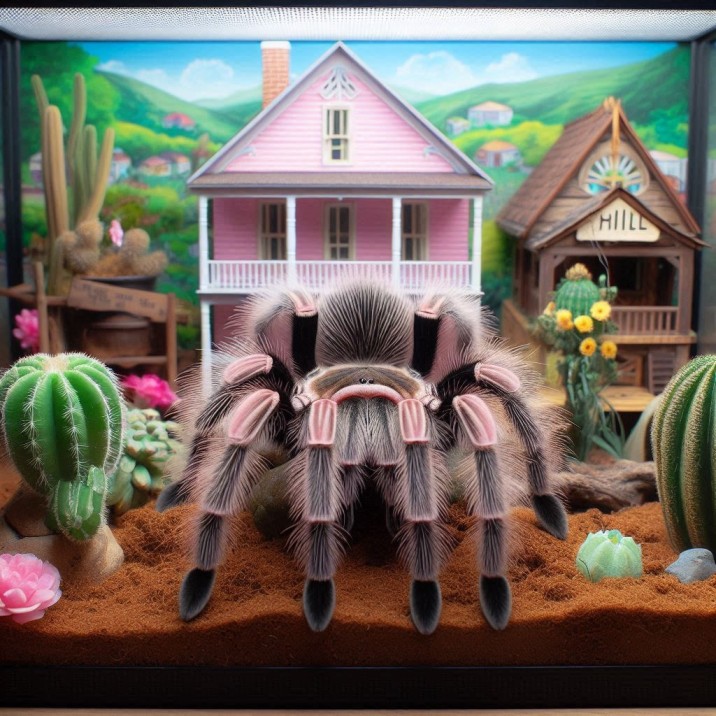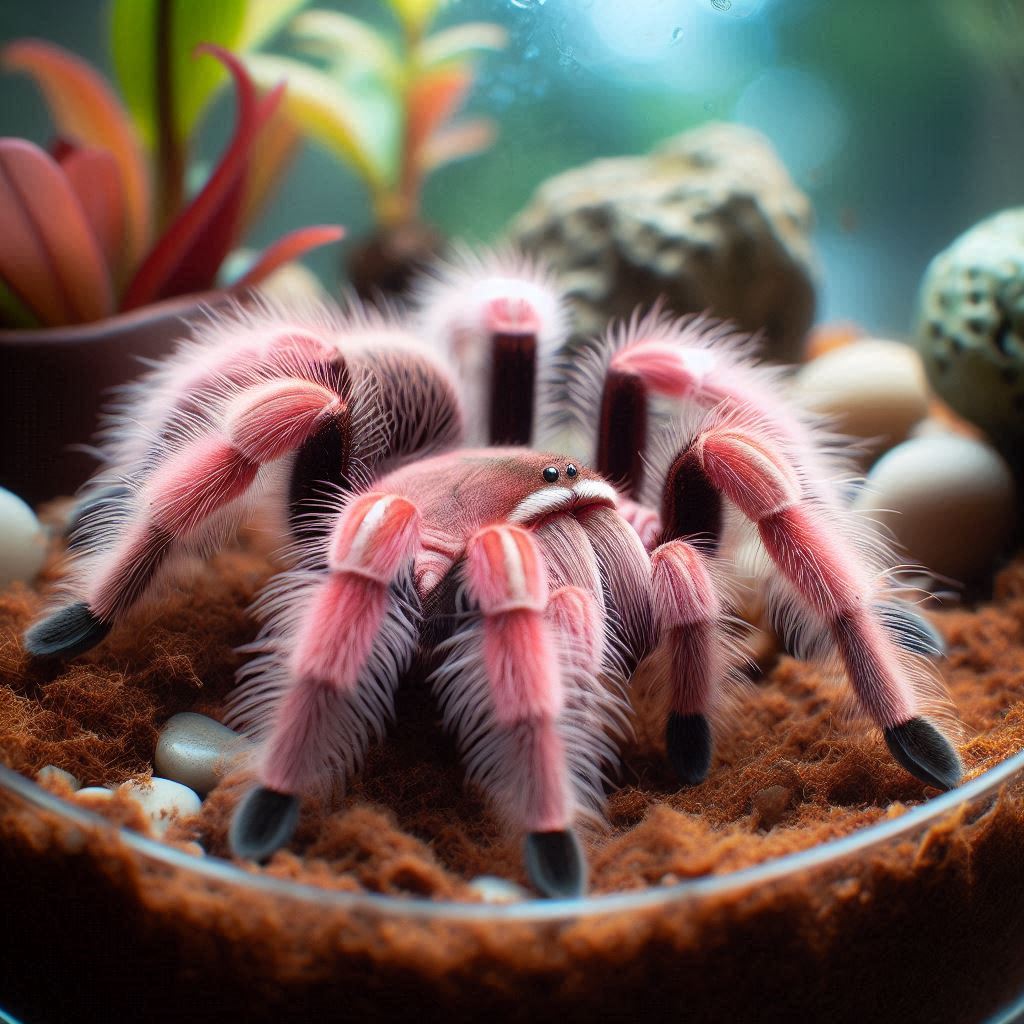Introduction
Table of Contents
The pink toe tarantula, also known as the Antilles pink toe tarantula (Avicularia versicolor), is a popular pet among arachnid enthusiasts. Known for its vibrant colors and gentle demeanor, the pink toe tarantula requires a specific type of enclosure to thrive. This guide will walk you through everything you need to know about setting up the perfect habitat for your pink toe tarantula enclosure. By following these tips, you’ll ensure your spider stays healthy and happy.

Understanding the Pink Toe Tarantula
Basic Facts About Pink Toe Tarantulas
- Scientific Name: Avicularia versicolor
- Lifespan: 5-10 years (females live longer)
- Size: 4.5-5 inches in leg span
- Habitat: Tropical and subtropical regions
Natural Habitat
Pink toe tarantulas are native to the Caribbean islands, particularly Martinique and Guadeloupe. They thrive in warm, humid environments and are arboreal, meaning they live in trees. Replicating this natural habitat in captivity is crucial for their well-being.
Setting Up the Pink Toe Tarantula Enclosure
Choosing the Right Pink Toe tarantula Enclosure
The first step in creating a comfortable home for your pink toe tarantula is selecting the right enclosure.
Size and Type
- Minimum Size: 12 x 12 x 18 inches
- Material: Glass or acrylic tanks are ideal for visibility and humidity control.
- Vertical Space: Since pink toe tarantulas are arboreal, the height of the enclosure is more important than the floor space.
Ventilation
Proper ventilation is essential to prevent mold growth and maintain humidity levels. Ensure your enclosure has plenty of ventilation holes.
Substrate
A suitable substrate will help maintain humidity and provide a comfortable surface for your tarantula.
Recommended Substrates
- Coconut fiber: Retains moisture well and is soft for the tarantula.
- Peat moss: Another good option for moisture retention.
- Avoid: Sand or gravel, as they do not retain moisture and can be abrasive.
Decor and Climbing Structures
Pink toe tarantulas love to climb and need plenty of vertical structures.
Climbing Structures
- Cork bark: Provides a natural climbing surface.
- Branches: Real or artificial branches can mimic their natural habitat.
- Silk plants: Add visual appeal and additional climbing surfaces.
Humidity and Temperature
Maintaining the right humidity and temperature is crucial for your tarantula’s health.
Ideal Conditions
- Humidity: 70-80%
- Temperature: 75-85°F
Use a hygrometer and thermometer to monitor these conditions regularly.
Water and Feeding
Your pink toe tarantula needs a shallow water dish and a varied diet.
Water Dish
- Size: Small and shallow to prevent drowning.
- Placement: Ensure it’s easily accessible.
Diet
- Insects: Crickets, roaches, and mealworms.
- Feeding Schedule: Young tarantulas need to eat more frequently (every 2-3 days), while adults can be fed once a week.
Maintenance and Care For Pink Toe Tarantula Enclosure
Cleaning the Enclosure
Regular cleaning is essential to prevent mold and bacteria buildup.
Routine Cleaning
- Spot Cleaning: Remove uneaten food and waste daily.
- Deep Cleaning: Replace the substrate and clean the enclosure thoroughly every few months.
Handling Your Tarantula
Pink toe tarantulas are generally docile but should be handled with care.
Tips for Handling
- Gentle Touch: Use a soft brush to coax the tarantula onto your hand.
- Avoid Stress: Minimize handling to prevent stress.
Common Issues and Solutions
Molting
Molting is a critical process for tarantulas as they grow.
Signs of Molting
- Decreased Activity: Your tarantula may become less active.
- Dull Color: The exoskeleton appears dull before molting.
Post-Molting Care
- Increased Humidity: Ensure higher humidity to help with the molting process.
- Do Not Feed: Avoid feeding until the new exoskeleton hardens.
Health Problems
Common health issues include dehydration and mites.
Dehydration
- Symptoms: Lethargy and shriveled abdomen.
- Solution: Provide fresh water and maintain humidity.
Mites
- Symptoms: Small white or red dots on the tarantula.
- Solution: Clean the enclosure and replace the substrate.
Conclusion
Creating the perfect enclosure for your pink toe tarantula requires attention to detail and regular maintenance. By providing the right environment, you’ll ensure your tarantula lives a healthy and happy life. Remember to monitor humidity and temperature, provide ample climbing structures, and maintain cleanliness in the enclosure.
Table of Information
| Aspect | Details |
|---|---|
| Enclosure Size | Minimum 12 x 12 x 18 inches |
| Substrate | Coconut fiber, peat moss |
| Humidity | 70-80% |
| Temperature | 75-85°F |
| Climbing Structures | Cork bark, branches, silk plants |
| Water Dish | Small and shallow |
| Diet | Crickets, roaches, mealworms |
| Cleaning Frequency | Daily spot clean, bi-monthly deep clean |
FAQs About Pink Toe Tarantula Enclosure
1. What size enclosure does a pink toe tarantula need?
A minimum of 12 x 12 x 18 inches is recommended to provide ample vertical space for climbing.
2. How often should I feed my pink toe tarantula?
Young tarantulas should be fed every 2-3 days, while adults can be fed once a week.
3. What should the humidity level be for a pink toe tarantula?
The humidity should be maintained at 70-80%.
4. Can I handle my pink toe tarantula?
Yes, but handle it gently and infrequently to avoid stress.
5. How do I know if my tarantula is about to molt?
Signs include decreased activity and a duller color on its exoskeleton.

